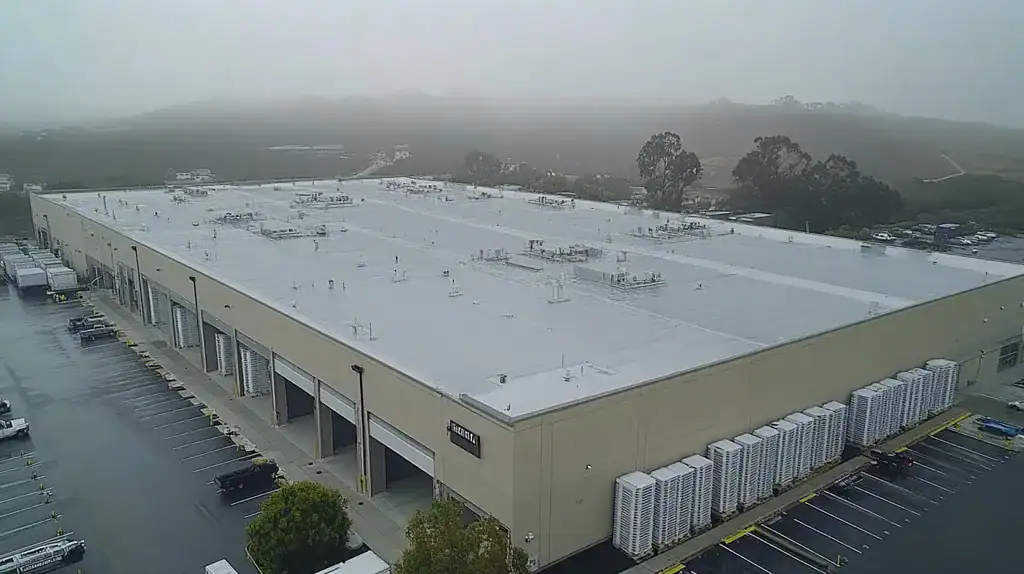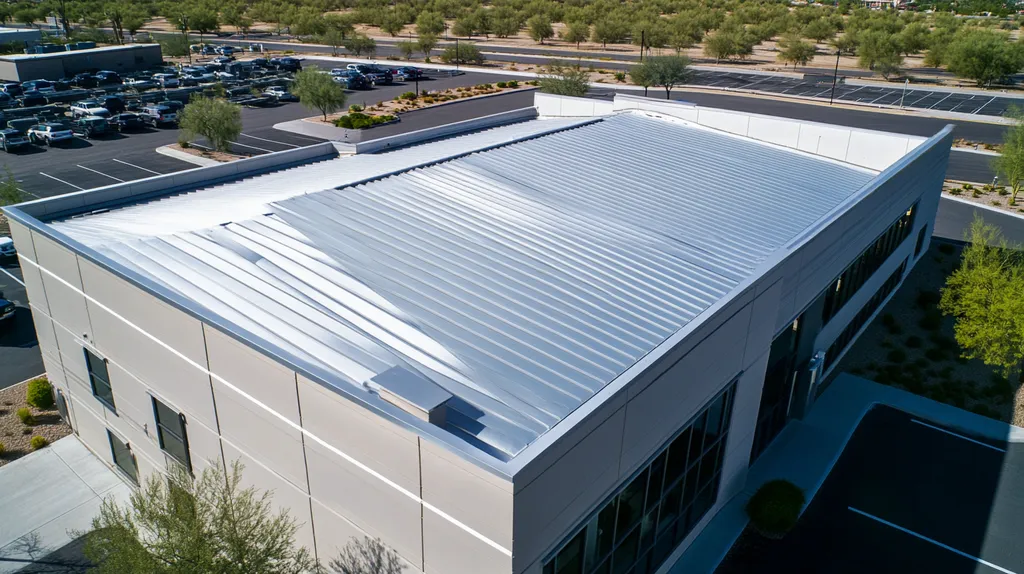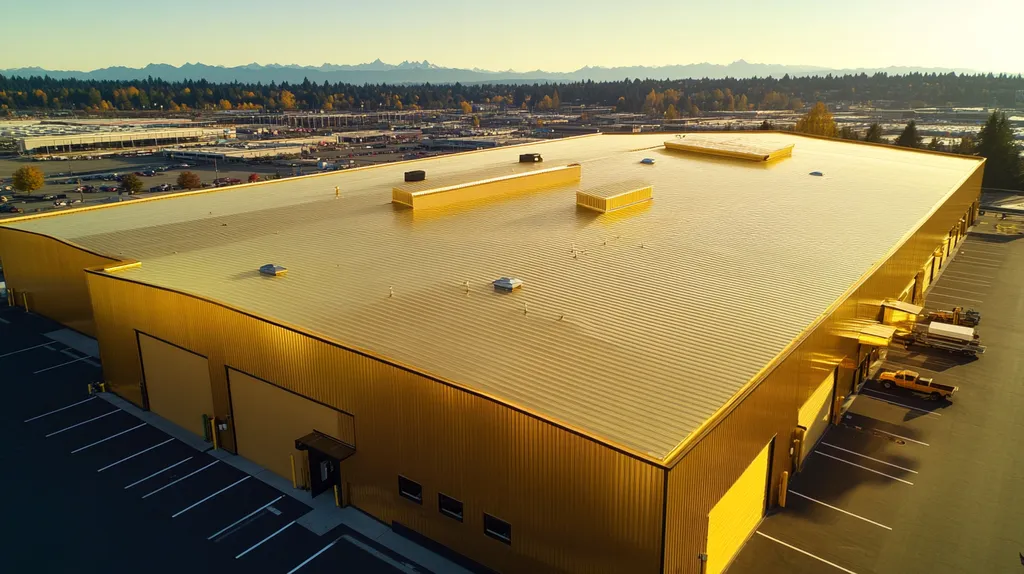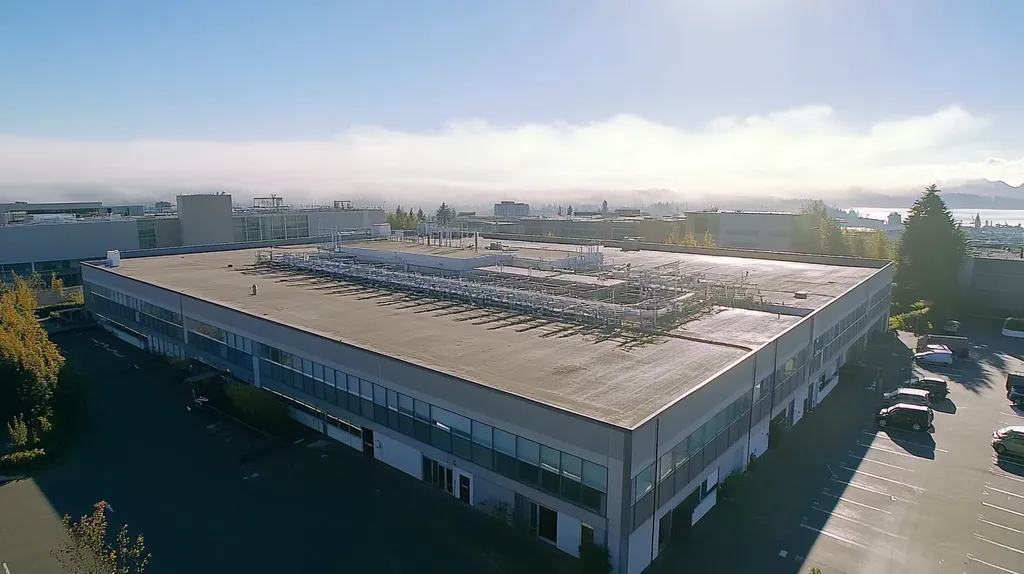Welcome to today’s Battle Royale featuring two roofing heavyweights: “Cool Roofs” in the east corner versus “Green Roofs” in the west!
Tonight’s showdown pits these contenders against each other across six punishing rounds designed to test every aspect of their performance for Aesthetic Enhancement.
At stake? Millions in potential costs, decades of building protection, and the critical performance demands of modern commercial and industrial facilities.
Our professional judging panel will evaluate each round on technical merit, real-world performance, and value delivery. After all six rounds, we’ll declare our ultimate champion.
Ladies and gentlemen, facility managers and building owners… it’s time to rumble!
ROUND 1: INITIAL COSTS & INSTALLATION
When considering a commercial roof upgrade, the initial investment and installation process can make or break the project’s viability. Modern roofing decisions impact not just immediate costs, but also installation timelines, structural requirements, and operational disruptions. For facility managers and property owners, understanding these upfront commitments helps prevent costly mistakes and ensures alignment with both budget constraints and building enhancement goals.
Material Expenses
Material costs represent the foundation of any roofing project’s budget. Cool roofs typically utilize reflective coatings or single-ply membranes, with costs ranging from $3-$6 per square foot for basic materials, making them an accessible option for most commercial properties.
Green roof materials demand significantly higher investment, typically $10-$30 per square foot. These costs cover waterproofing membranes, root barriers, drainage systems, growing media, and vegetation – all essential components of a functioning green roof system.
While both options require quality materials to ensure longevity, the substantial cost difference makes cool roofs more financially accessible for most commercial applications. The simpler material requirements also reduce the risk of supply chain delays or material compatibility issues.
In material expenses, cool roofs claim a clear “ADVANTAGE” due to lower costs and simpler material requirements.
Installation Complexity
Cool roof installation typically follows standard roofing procedures, requiring minimal specialized training beyond traditional roofing skills. Most installations can be completed using existing crews and standard equipment, streamlining the process.
Green roof installation demands extensive expertise in both roofing and landscaping. The process requires careful coordination between structural engineers, roofing contractors, and landscape specialists to ensure proper implementation.
The complexity of green roof installations also increases the risk of errors, potentially leading to costly repairs or modifications. Each layer must be meticulously installed to prevent water damage and ensure proper plant growth.
Due to simpler installation requirements and lower technical complexity, cool roofs gain another “ADVANTAGE” in this category.
Project Timeline
Time efficiency in commercial roofing directly impacts both costs and business operations. Cool roof installations typically require 5-10 working days for an average commercial building, allowing quick return to normal operations.
Green roof installations commonly extend to 3-6 weeks or longer, depending on the system’s complexity. This timeline includes structural reinforcement, waterproofing, growing medium installation, and initial vegetation establishment.
The extended timeline for green roofs also increases exposure to weather-related delays and complications. Each phase must be properly completed before moving to the next, creating multiple potential delay points.
In project timeline considerations, cool roofs secure another “ADVANTAGE” through faster completion and reduced disruption.
ROUND 1 WINNER: COOL ROOFS
ROUND 2: DURABILITY & LIFESPAN
When evaluating commercial roofing investments, durability and longevity directly impact both maintenance budgets and asset value. Modern roofing systems must withstand increasingly extreme weather patterns while maintaining their protective and aesthetic properties. Understanding how different roofing solutions perform over time helps property owners make informed decisions that balance immediate needs with long-term facility management goals.
Weather Resistance
Weather resistance determines how well a roofing system maintains its protective properties under various environmental conditions. Cool roofs excel in hot climates, with their reflective surfaces effectively defending against UV radiation and heat-related deterioration. Their simple construction also reduces potential failure points during severe weather events.
Green roofs provide natural insulation against temperature extremes and effectively manage stormwater runoff. The multiple layers and living components actually shield the underlying waterproofing membrane from weather damage, often extending its functional life beyond traditional systems.
While both options offer strong weather resistance, green roofs demonstrate superior protection against multiple environmental stressors. The living barrier provides an “ADVANTAGE” in this category through enhanced natural shielding.
Structural Integrity
Cool roofs maintain structural integrity through simplified design and materials engineered specifically for weather resistance. Their lighter weight reduces stress on building structures, while modern coating technologies provide excellent resistance to cracking and peeling.
Green roof systems require robust structural support but offer excellent protection for the underlying roof membrane. The multiple layers work together to absorb movement and protect against physical damage, though this depends heavily on proper installation and maintenance.
With properly engineered solutions, both options can maintain their structural integrity over time. This category results in a “TIE” as success depends more on quality installation than inherent system characteristics.
Maintenance Requirements
Cool roofs typically require minimal maintenance beyond periodic cleaning and recoating. Their simple construction makes inspections straightforward and repairs relatively uncomplicated when needed. Annual maintenance costs generally remain predictable and manageable.
Green roofs demand regular attention to vegetation health, irrigation systems, and drainage pathways. While this ongoing maintenance requires more effort, it allows early detection of potential issues before they become serious problems. The living components also self-repair minor damage through natural growth.
Though green roofs require more frequent maintenance, their self-healing properties and enhanced protection of underlying components give them an “ADVANTAGE” in long-term durability.
ROUND 2 WINNER: GREEN ROOFS
ROUND 3: PERFORMANCE FACTORS
Performance factors make or break a commercial roofing investment, directly impacting both immediate operations and long-term facility value. Modern roofing systems must deliver measurable returns through reduced energy costs, enhanced durability, and improved storm resilience. Understanding these performance metrics helps property owners maximize their roofing investment while meeting aesthetic and functional goals.
Energy Efficiency
Energy efficiency represents a critical factor in commercial roofing selection, with potential savings directly affecting operational budgets. Cool roofs excel in this area, using reflective surfaces to dramatically reduce heat absorption and lower cooling demands during peak summer months.
These reflective properties can reduce cooling costs by up to 30% in warm climates, making cool roofs particularly attractive for facilities with high air conditioning loads. The energy benefits remain consistent throughout the roof’s lifespan with minimal maintenance requirements.
Green roofs provide natural insulation through their vegetation and growing medium layers, helping regulate indoor temperatures. However, they require energy inputs for irrigation systems and maintenance equipment, partially offsetting their thermal benefits.
For energy efficiency, cool roofs claim the ADVANTAGE through immediate and sustained energy savings.
Durability
Garden roofs incorporate multiple protective layers, including specialized drainage systems that prevent water damage while supporting plant growth. These systems can provide decades of service when properly maintained, offering both functional and aesthetic benefits. (source: APX Construction Group)
Cool roofs utilize advanced materials engineered specifically for weather resistance and longevity. Their simple construction reduces potential failure points, while modern coating technologies provide excellent protection against UV damage and thermal stress.
The multiple layers in green roofs can present maintenance challenges, particularly if water infiltration occurs. Root barriers must remain intact to prevent vegetation from compromising the waterproofing membrane.
Given their simpler maintenance requirements and fewer potential failure points, cool roofs gain the ADVANTAGE in durability.
Storm Resistance
Storm resistance capabilities directly impact building protection and insurance costs. Cool roofs provide excellent wind resistance through their lightweight construction and strong membrane attachment methods.
Their smooth surfaces also resist impact damage from hail and debris, while maintaining water-shedding capabilities during heavy rainfall. Regular inspections can quickly identify and address any storm-related damage.
Green roofs excel at managing stormwater runoff through natural absorption and controlled release. However, saturated growing medium can place significant weight loads on the structure during extended storms.
With both systems offering distinct storm management benefits, this category results in a TIE.
ROUND 3 WINNER: COOL ROOFS
ROUND 4: MAINTENANCE REQUIREMENTS
Maintenance requirements can make or break a commercial roofing investment’s long-term success. Industry data shows that over 75% of premature roof failures stem from inadequate maintenance practices. Understanding the distinct upkeep needs of different roofing systems helps property owners avoid costly repairs while preserving both function and aesthetics.
Routine Inspection Requirements
Cool roofs demand regular inspections to maintain their reflective properties and ensure optimal performance. These typically involve quarterly visual checks and annual detailed assessments to identify potential issues before they escalate.
Inspections focus on surface coating integrity, seam conditions, and drainage pathways. Early detection of problems like coating wear or membrane separation allows for targeted repairs rather than extensive replacements.
Green roofs require monthly inspections to monitor plant health, irrigation effectiveness, and drainage function. These assessments must address both horticultural and structural aspects, demanding specialized expertise.
Due to simpler inspection protocols and lower expertise requirements, cool roofs gain the ADVANTAGE in this category.
Cleaning and Preventive Care
Cool roof maintenance centers on preserving reflective properties through periodic cleaning and recoating. Most systems need thorough cleaning annually, with additional spot cleaning in areas prone to debris accumulation.
Urban environments may require more frequent cleaning to maintain energy efficiency. However, the process remains straightforward and can typically be performed by standard maintenance crews.
Green roofs demand continuous attention to vegetation management, including weeding, pruning, and replanting. Irrigation systems require regular adjustment and repair, while growing medium needs periodic testing and amendment.
With significantly lower ongoing care requirements, cool roofs secure another ADVANTAGE.
Repair Complexity
When damage occurs, cool roof repairs generally involve straightforward processes like patching or recoating. Maintenance teams can usually address minor issues quickly, minimizing potential for further damage.
Most repairs can be completed without specialized equipment or extensive facility disruption. The simple system design allows for targeted fixes without impacting surrounding areas.
Green roof repairs often involve multiple layers and components, requiring careful coordination between roofing and landscaping specialists. Even minor issues may necessitate removing and replacing vegetation and growing medium to access underlying problems.
The simpler repair requirements give cool roofs a clear ADVANTAGE in this category.
ROUND 4 WINNER: COOL ROOFS
ROUND 5: SUSTAINABILITY CREDENTIALS
Environmental impact increasingly drives commercial roofing decisions as climate change reshapes building requirements. With buildings accounting for 40% of urban energy consumption, roofing choices directly impact both facility operations and environmental footprint. Modern roofing solutions must balance immediate performance with long-term sustainability goals while meeting aesthetic requirements.
Energy Performance
Energy efficiency through roofing directly impacts both operational costs and environmental footprint. Cool roofs excel in this area by reflecting up to 80% of solar radiation, dramatically reducing cooling loads during peak summer months.
These reflective properties maintain their effectiveness with minimal maintenance, providing consistent energy savings throughout the roof’s lifespan. The simple surface technology also allows for easy cleaning and recoating to maintain optimal performance.
Green roofs offer natural insulation through vegetation and soil layers, but their energy benefits vary with plant health and seasonal changes. The irrigation and maintenance systems required for green roofs also consume energy, partially offsetting their thermal benefits.
For consistent energy performance and lower operational demands, cool roofs claim the ADVANTAGE.
Environmental Impact
Cool roofs contribute to urban heat island reduction by reflecting solar radiation rather than absorbing it. This passive cooling effect benefits both individual buildings and surrounding neighborhoods, creating a multiplicative environmental benefit.
Their simple material composition also reduces manufacturing impact and allows for easier recycling at end-of-life. Installation requires fewer resources and generates minimal waste compared to complex roofing systems.
Green roofs excel at supporting biodiversity and managing stormwater runoff through natural processes. However, their complex installation and intensive maintenance requirements increase their overall environmental footprint.
With lower resource demands and broader environmental benefits, cool roofs secure another ADVANTAGE.
Long-term Sustainability
Cool roofs demonstrate excellent longevity through simple, durable construction that resists environmental degradation. Their reflective surfaces maintain effectiveness with basic maintenance, ensuring sustained environmental benefits.
The straightforward repair processes for cool roofs minimize material waste and reduce the frequency of major replacements. This efficiency extends their functional lifespan while maintaining performance.
Green roofs require ongoing resource inputs for plant maintenance and system operation. While they provide valuable ecosystem services, their complex maintenance needs and shorter functional lifespans complicate their long-term sustainability profile.
Based on operational efficiency and reduced resource demands, cool roofs gain the ADVANTAGE.
ROUND 5 WINNER: COOL ROOFS
ROUND 6: SPECIALIZED APPLICATIONS
Specialized roofing applications represent a critical decision point for commercial properties, with 73% of facilities managers citing application-specific requirements as a primary factor in system selection. Modern commercial buildings face unique challenges in balancing aesthetic appeal with performance demands. Understanding how different roofing systems adapt to specialized needs helps property owners maximize both visual impact and functional success.
High-Visibility Applications
Buildings with high public visibility demand roofing solutions that enhance architectural appeal while maintaining performance. Cool roofs offer clean, modern aesthetics through their reflective surfaces, creating a sophisticated appearance that complements contemporary architecture.
The uniform appearance of cool roofs provides visual consistency across large commercial developments. Their reflective properties can create striking visual effects, particularly in urban settings where buildings are viewed from multiple angles.
Green roofs transform visible roof areas into vibrant, living landscapes that change with the seasons. They create unique viewing opportunities from neighboring buildings and can serve as signature design elements that distinguish properties in competitive markets.
For high-visibility applications, green roofs gain the ADVANTAGE through their dynamic aesthetic appeal and ability to create distinctive visual landmarks.
Environmental Integration
Modern commercial properties must integrate effectively with their surrounding environment. Cool roofs excel in urban settings by reducing heat island effects and creating visually cohesive roofscapes that complement city skylines.
Their reflective properties help buildings blend with sky views while maintaining clean sight lines. This makes them particularly effective for properties in dense commercial districts where rooftop appearances impact neighboring buildings.
Green roofs significantly reduce stormwater runoff and improve air quality while providing natural insulation benefits that decrease energy consumption. They create seamless transitions between built and natural environments, particularly valuable in mixed-use developments and campus settings. (source: CT Roofing Contractors)
In environmental integration, green roofs secure the ADVANTAGE through superior ecological connectivity and natural aesthetic appeal.
Functional Aesthetics
Commercial roofing must balance visual appeal with practical functionality. Cool roofs maintain their aesthetic properties with minimal maintenance, ensuring consistent appearance even under challenging conditions.
Their simple surfaces facilitate equipment mounting and maintenance access while preserving clean sight lines. This makes them ideal for properties requiring extensive rooftop mechanical systems.
Green roofs transform functional spaces into usable environments that enhance property value. They create opportunities for rooftop amenities while screening mechanical equipment through natural landscaping.
For combining aesthetics with functionality, both systems offer unique benefits, resulting in a TIE.
ROUND 6 RESULTS: TIE
AND THE WINNER IS…
After six grueling rounds of technical evaluation, we have our verdict… In a decisive victory, taking four rounds with one tie, COOL ROOFS emerge as our heavyweight champion of aesthetic enhancement!
Cool roofs dominated the scorecards through superior performance in initial costs, maintenance simplicity, and sustainability credentials. Their combination of reliable performance and straightforward upkeep proved unstoppable in the commercial arena.
But don’t count green roofs out completely! These living champions proved their worth in Round 2’s durability battle and showed remarkable strength in specialized applications. For properties seeking maximum environmental integration or unique aesthetic statements, green roofs remain a formidable contender.
Remember, ladies and gentlemen, every building brings its own unique requirements to the ring. Local climate conditions, structural specifications, and property-specific characteristics can dramatically impact performance. While this analysis provides general guidance, it cannot account for all variables. Property owners should always consult qualified roofing professionals who can evaluate their specific situation before making their final selection.
In the high-stakes world of commercial roofing, victory doesn’t always go to the strongest contender – it goes to the solution that best matches your building’s specific requirements. Choose your champion wisely!
FREQUENTLY ASKED QUESTIONS
Q. What are the initial costs for a commercial roof upgrade?
A. Initial costs vary significantly between cool roofs and green roofs. Cool roofs are generally more affordable, costing about $3-$6 per square foot, while green roofs can range from $10-$30 per square foot. Understanding these differences is key for setting a realistic budget.
Q. How does durability differ between an industrial roof and a green roof?
A. Durability largely depends on the materials and construction methods used. Green roofs generally offer superior protection against environmental stressors due to their layered design, while industrial roofs may require less maintenance and simpler repairs, impacting longevity.
Q. Are cooling costs affected by using a commercial roof?
A. Yes, different roofing types impact cooling costs. Reflective surfaces in cool roofs can reduce indoor temperatures, leading to lower energy bills. In contrast, green roofs provide insulation but may have higher energy needs for maintenance, affecting overall cooling costs.
Q. What are the maintenance requirements for a commercial roof?
A. Maintenance varies significantly between roof types. Cool roofs require periodic cleaning and inspections, while green roofs need regular care for vegetation health. Understanding these requirements is essential for long-term performance and cost management.
Q. Which roof type is more sustainable for a commercial property?
A. Cool roofs generally outperform green roofs in sustainability due to lower resource demands and ease of maintenance. They reflect solar radiation better, reducing energy consumption while minimizing environmental impact, making them an attractive choice for sustainability-focused property owners.
Q. How does a green roof enhance aesthetics in commercial buildings?
A. Green roofs transform traditional rooftops into vibrant landscapes, enhancing visual appeal significantly. They provide unique design features that improve building aesthetics and offer valuable outdoor spaces for occupants, helping to make a strong architectural statement.
Q. Can green roofs manage stormwater effectively?
A. Yes, green roofs are highly effective at stormwater management. Their layers absorb rainfall and reduce runoff, helping to mitigate flooding and erosion. Additionally, they enhance the local ecosystem, offering significant environmental benefits beyond traditional roofing solutions.










